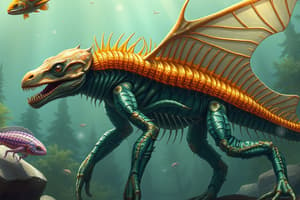Podcast
Questions and Answers
Which statement accurately describes metazoans?
Which statement accurately describes metazoans?
What type of symmetry does a bilaterally symmetrical animal possess?
What type of symmetry does a bilaterally symmetrical animal possess?
Which classification system is based on the number of germ layers?
Which classification system is based on the number of germ layers?
What was a significant contributor to the Cambrian explosion of multicellular animals?
What was a significant contributor to the Cambrian explosion of multicellular animals?
Signup and view all the answers
What characterizes bilateral symmetry in animals?
What characterizes bilateral symmetry in animals?
Signup and view all the answers
Which of the following describes diploblastic organisms?
Which of the following describes diploblastic organisms?
Signup and view all the answers
What was one of the first known locations of metazoans?
What was one of the first known locations of metazoans?
Signup and view all the answers
What aspect primarily differentiates triploblastic organisms from diploblastic ones?
What aspect primarily differentiates triploblastic organisms from diploblastic ones?
Signup and view all the answers
What distinguishes acoelomates from coelomates?
What distinguishes acoelomates from coelomates?
Signup and view all the answers
Which term refers to an organism with a body cavity that is not completely lined by mesodermal tissue?
Which term refers to an organism with a body cavity that is not completely lined by mesodermal tissue?
Signup and view all the answers
What is the process of coelom formation in protostomes called?
What is the process of coelom formation in protostomes called?
Signup and view all the answers
What type of cleavage is associated with deuterostomes?
What type of cleavage is associated with deuterostomes?
Signup and view all the answers
Which of the following is NOT a classification of symbiosis?
Which of the following is NOT a classification of symbiosis?
Signup and view all the answers
Which feeding habit consists of organisms that consume dead organic matter?
Which feeding habit consists of organisms that consume dead organic matter?
Signup and view all the answers
What type of symbionts live within the body of another participant?
What type of symbionts live within the body of another participant?
Signup and view all the answers
Based on habitat classification, which term describes animals that live on land?
Based on habitat classification, which term describes animals that live on land?
Signup and view all the answers
What is a defining feature of eucoelomates?
What is a defining feature of eucoelomates?
Signup and view all the answers
What is the key difference between commensalism and mutualism?
What is the key difference between commensalism and mutualism?
Signup and view all the answers
Study Notes
Metazoans
- Oldest known multicellular organisms, dating back 543 to 635 million years, discovered within Ediacaran fauna in South Africa.
- Cambrian period marked by significant fossil findings, including the Burgess Shale located in British Columbia, discovered in 1909.
- Cambrian Explosion refers to a rapid diversification of complex animals over millions of years.
Classification Systems
- Classifications are primarily based on criteria like cell number, body symmetry, developmental patterns, evolutionary relationships, habitat, feeding habits, and symbiosis.
Classification by Cell Number
- Metazoans: Multicellular, generally diploid organisms developed from a blastula.
- Other Invertebrates: Unicellular or acellular, lacking development from a metazoan embryo.
Body Symmetry
- Bilateral Symmetry: Organisms have right and left sides that are mirror images; associated with cephalization, where nervous and sensory structures concentrate at one end.
- Radial Symmetry: Organisms can be divided into equal halves by multiple cuts through the center.
Developmental Patterns and Germ Layers
- Diploblastic: Two distinct germ layers (ectoderm and endoderm) are formed.
- Triploblastic: Three distinct germ layers (ectoderm, mesoderm, and endoderm) are formed.
Coelom Classification
- Coelom: Fluid-filled body cavity lying between gut and muscles, lined with mesodermal tissue.
- Acoelomates: Lack a coelom, with solid tissue between the gut and body wall.
- Pseudocoelomates: Possess a false coelom, a fluid-filled space between the gut and body wall musculature.
- Coelomates/Eucoelomates: Have a true coelom formed from mesoderm tissue, facilitating complex organ development.
Coelom Formation
- Protostomes: Form coelom through schizocoely, where the coelom enlarges from splits in the mesoderm.
- Deuterostomes: Form coelom through enterocoely, where it develops from pouches of the gut.
Cleavage Patterns
- Involvement of animal and vegetal poles during embryonic development with different cleavage types such as radial cleavage seen in deuterostomes and indeterminate cleavage found in protostomes.
Evolutionary Relationships
- Biological classification follows a hierarchical system from kingdom down to species (Kingdom, Phylum, Class, Order, Family, Genus, Species).
Habitat Classification
- Terrestrial: Organisms that inhabit land.
- Marine: Various marine habitats include intertidal, subtidal, and open ocean zones.
- Organisms categorized based on mobility: mobile, sessile, and sedentary, as well as planktonic types.
Feeding Habits
- Classification based on diet includes herbivores, carnivores, omnivores, decomposers, detritivores, suspension feeders, and deposit feeders.
Symbiotic Relationships
- Mutualism: Both species involved benefit from the interaction.
- Commensalism: One participant benefits while the other is neither helped nor harmed.
- Parasitism: One organism benefits at the expense of the other, potentially causing harm.
Types of Symbionts
- Ectosymbionts: Live on the surface of the host organism.
- Endosymbionts: Reside within the body of the host organism, often impacting physiological processes.
Studying That Suits You
Use AI to generate personalized quizzes and flashcards to suit your learning preferences.
Related Documents
Description
Explore the fascinating world of invertebrates with this quiz on their classification and evolutionary relationships. Learn about the early multicellular animals, the Ediacaran fauna, and the Cambrian explosion. Test your knowledge of metazoans and their significance in biological history.




